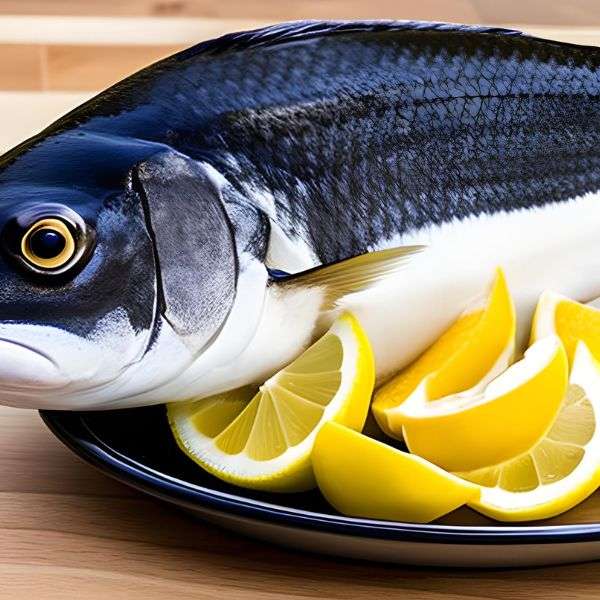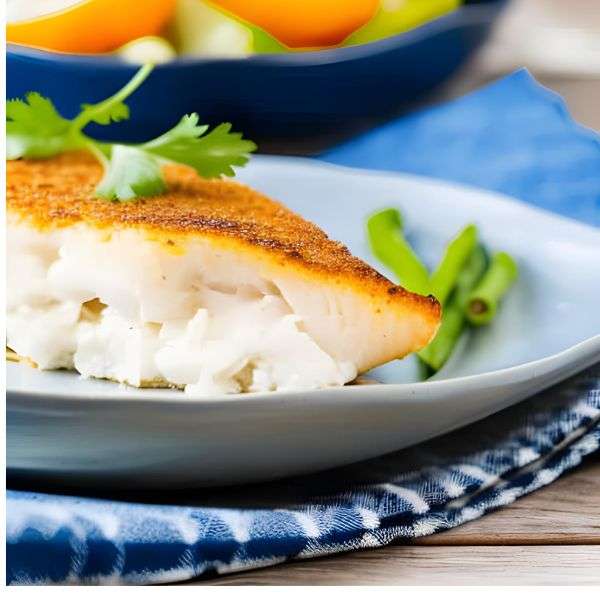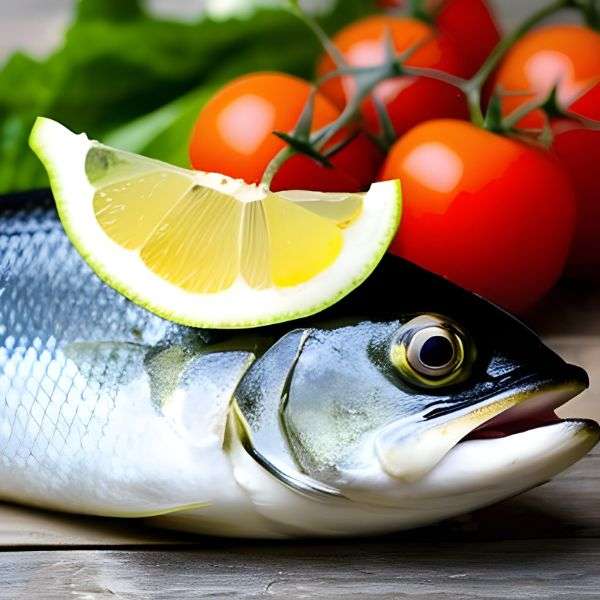Every pet owner is concerned about the dietary needs of their dogs and wants to expand the menu of their dog’s diet, It’s important to choose healthy foods. One of the famous seafood among so many treats is haddock fish, but the question arises, “Can dogs eat haddock fish?”
The short answer is Yes! You can safely feed haddock fish to your dog, but moderation is required, It rich source of several proteins and minerals.
In this article, we will be sharing with you the complete nutritional composition of the haddock fish, its health benefits for your pup, some considerations, and potential risks.
So, without any further delay, let;’s get started!
Understanding Haddock Fish
Haddock fish (Melanogrammus aeglefinus) is a species of fish that belongs to the Gadidae family. You can find this fish in the cold waters of the North Atlantic Ocean, particularly in regions such as the North Sea, the Gulf of Maine, and the Norwegian Sea.

This fish has a special silver-gray color and a black line on its side. Many humans around the world like this fish so much because of its gentle and tasty flavor.
Haddock fish is used in many different dishes like fish and chips, chowders, and baked recipes. This means haddock can be used in many different ways of cooking.
Haddock is a great source of lean protein and contains essential nutrients like omega-3 fatty acids, vitamin B12, selenium, and phosphorus.
Nutritional Composition of Haddock Fish
Here’s a table highlighting the nutritional composition of Haddock Fish:
| Nutrient | Amount per 100g |
|---|---|
| Protein | 16.3 grams |
| Total Fat | 0.45 grams |
| Ash | 1.28 grams |
| Carbohydrate | 0 grams |
These values represent the approximate nutritional content found in 100 grams of raw haddock fish.
Can Dogs Eat Haddock Fish?
Yes, dogs can safely consume haddock fish in moderation. Haddock fish is a lean source of protein and contains essential nutrients such as omega-3 fatty acids, vitamin B12, selenium, and phosphorus.
When you are feeding haddock fish for your dog, it is important to remove any kind of bonces and avoid using seasonings and spices. Always start feeding with small amounts and then slowly increase it.
Benefits of Haddock Fish for Dogs
Haddock fish provides health benefits to dogs if you give them the required right amount. Consider the following benefits:

Rich in lean protein:
Haddock fish is a great source of lean protein, which is essential for dogs’ overall health and muscle development. Protein supports strong bones, healthy skin, and a robust immune system.
Omega-3 fatty acids:
Haddock fish has lots of omega-3 fatty acids, like EPA and DHA. These fatty acids are really important because they keep the brain healthy, reduce swelling, and make the coat shiny.
Vitamin B12:
Haddock fish contains vitamin B12, which is an essential nutrient that helps in the production of red blood cells and it also supports proper nervous system function in dogs.
Selenium:
Haddock fish also contains selenium which is a trace mineral. This mineral helps to protect the cells from damage in dogs. Selenium also maintains a healthy immune system.
Phosphorus:
Dogs need phosphorus for strong bones and teeth, and haddock fish has this important mineral. It helps their bones grow strong and keeps their body working well.
Palatability and variety:
Haddock fish has a yummy taste that lots of dogs love. Giving them this fish can make mealtime more interesting and add some variety to their food, which is great if your dog is picky about eating.
Before adding any new food to your dog’s diet, talk to your vet first. They’ll make sure it’s okay for your dog and fits their special needs and health conditions.
Risks and Considerations of Haddock Fish for Dogs
If you do not feed the haddock fish in the right amount and in an accurate way, it can become dangerous for dogs. So you have to be careful in this regard. Consider the following health risks:
Bones:
Haddock fish, like other fish, might have tiny bones that can be dangerous if your dog swallows them. Before you give haddock fish to your dog, be sure to take out all the bones carefully to keep them safe.

Allergies and sensitivities:
Some dogs can be allergic or sensitive to many fish, including haddock fish. Watch for signs like itching, swelling, tummy troubles, or breathing problems. You should keep an eye on your dog when you give them haddock fish for the first time to make sure they’re okay with it.
Mercury content:
While haddock fish generally has low mercury levels compared to certain larger fish species, it is still important to be mindful of mercury exposure.
High levels of mercury can be harmful to a dog’s health over time. Limit the frequency of feeding haddock fish to avoid excessive mercury intake.
Preparation and seasonings:
When you cook haddock fish for your dog, make sure not to add any spices or seasonings. Some spices can be harmful to dogs. So you must avoid using ingredients like onions, garlic, salt, or any other spices that are not safe for dogs to eat.
Individual dietary needs:
You should know that dogs have different dietary needs and not all the dogs have same health conditions as well. You have to consider factors such as your dog’s age, breed, weight, and any pre-existing health conditions.
By taking these risks and considerations into account, you can make informed choices regarding the inclusion of haddock fish in your dog’s meals.
How to Add Haddock Fish to Your Dog Diet?

Consult with your veterinarian: Before You add any new food to your dog’s diet, it’s important to consult with the vet as stated above. They can provide personalized advice based on your dog’s specific needs, dietary requirements, and any existing health conditions.
Start with small portions: You have to start with feeding small portions of haddock fish at the beginning of your dog. This allows you to monitor their response and ensure they tolerate it well. Also, observe for any signs of allergies or digestive issues.
Proper preparation: You have to completely cook the haddock fish so it doesn’t have any harmful bacteria. Ensure all bones are carefully removed to prevent choking hazards or digestive problems.
Serve it plain: When you are preparing the haddock fish for your dog, make sure not to use any seasonings, spices, or oils. Dogs have sensitive palates, and certain seasonings may be harmful to them. Keep it simple and serve the fish plain.
Monitor for reactions: After your dog eats the fish, make sure you monitor the reaction. Look for signs of allergies, such as itching, swelling, or gastrointestinal distress. If you see any bad reactions in your dog, stop feeding it and immediately talk to the vet.
Portion control: Haddock fish can be a great source of nutrition but it cannot act as a complete diet for your dog. You cannot replace your dog’s regular diet with haddock fish. Ensure proper portion control to maintain a balanced overall diet for your dog.
Best Alternatives of Haddock Fish for Your Dogs
You can select many healthy alternative options that are very healthy and safe for your dog. Here are some of the great alternatives to haddock fish:
Salmon: Salmon is a common fish that’s great for dogs because it has lots of omega-3 fatty acids. It helps their skin and coat, keeps their brain healthy, and lowers swelling, just like haddock fish.
Whitefish: Whitefish, like cod or flounder, is a good option if you don’t have haddock fish. They have a mild taste and give your dog lean protein, omega-3 fatty acids, and important nutrients. Remember to cook the whitefish well and take out all the bones before giving it to your dog.
Tuna: Tuna contains protein and dogs like eating food with protein. You can choose canned tuna in water, not oil, and make sure it’s safe for humans. Make sure you are not adding any salt or spices, just serve it plain.
Sardines: Sardines are little fish with lots of good stuff like omega-3 fatty acids, calcium, and vitamin D. You can give them to your dog as a treat or mix them with their usual food. Choose sardines in water without any salt or spices added. Remember to take out the tiny bones before feeding them to your dog.
Catfish: Catfish is another fish option for dogs, as it provides a good source of protein and essential nutrients. You should cook it thoroughly, boneless, and serve it without added spices or seasonings.
Remember, when introducing any new fish into your dog’s diet, consider their individual nutritional needs, and potential allergies, and consult with your veterinarian for guidance.
FAQs
Can dogs eat haddock fish raw?
No, it is not recommended to feed dogs raw fish, including haddock. Raw fish may contain harmful bacteria or parasites that can cause digestive issues or other health problems.
How much haddock fish can I feed my dog?
The amount of haddock fish you can feed your dog depends on their size, age, and overall health. It is important to maintain portion control and incorporate haddock fish as a part of a balanced diet.
Can dogs with allergies eat haddock fish?
If your dog has any kind of allergy, you shouldn’t feed haddock fish to your dog. You can also talk to your vet, in case of any allergies or sensitivities.
Are there any potential side effects of feeding haddock fish to dogs?
Haddock fish is usually safe for dogs, but if it’s not prepared or served well, there could be some problems. Your dog might choke on bones, have tummy troubles, or even have an allergic reaction.
Can I feed my dog commercially available haddock fish products?
You can try dog food or treats with haddock fish that you can buy in stores. But be sure to read the labels carefully. You must check that they do not contain any kind of seasonings, salt, or spices that can be dangerous for your dog.
Conclusion
In conclusion, Haddock fish can be a healthy and safe diet for your dog. You should only feed this to your dogs occasionally or once or twice a week.
By following the above guidelines, you can safely feed haddock fish and give your dog a tasty and healthy treat.
You can also feed healthy and safe alternatives covered above and give your dog sometimes unique digs. Always try to feed your dog with healthy and safe foods to keep it strong and fit.
Hopefully, you find this article helpful and if you want to learn more about the different foods for dogs, you can visit our other articles as well.
Happy Snaking!
